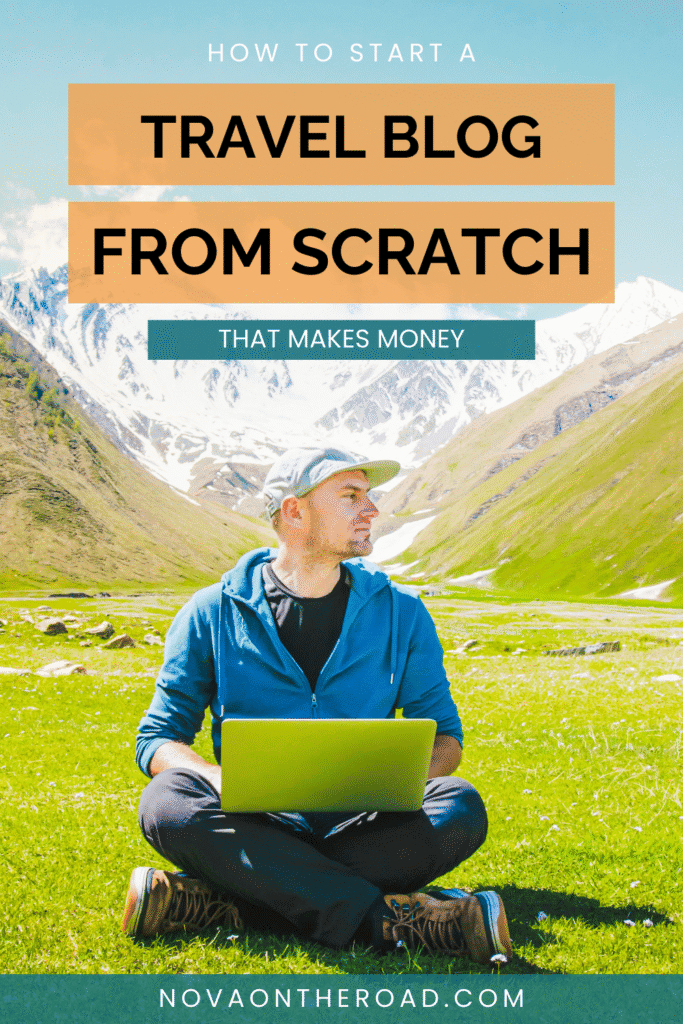How I would start a successful travel blog if I had to do it again.
Have you been thinking about starting a travel blog but feel a little overwhelmed? Or maybe you’re wondering if it’s too late to jump in? Don’t worry, you’re not behind. In this post, I’ll walk you through exactly how to start a travel blog from scratch and turn it into something that can actually make you money.
Ready to get paid to travel? Let’s dive in!
Disclosure: This post may contain affiliate links, which means that if you purchase through one of the product links, we’ll receive a small commission at no cost to you. We only promote products and services we 100% believe in. Thank you so much for supporting us! Read more about it in our disclosure policy.
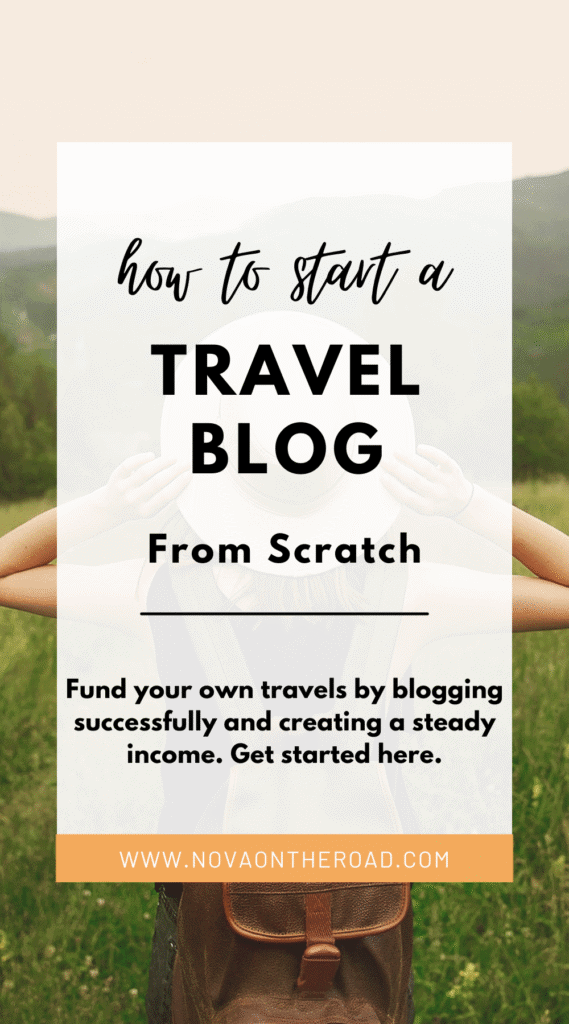
Can you still start a travel blog in 2025?
Absolutely! I understand the concerns about joining the game too late or that travel blogging’s too saturated… And the truth is, to succeed, you do need to specify a niche. Yes, blogging about everything that has to do with travel is totally possible, but it will also confuse Google about what your blog is actually about, which can lead to lower rankings.
And if this sounds confusing now, don’t worry, it’ll make sense in time. Blogging is mostly about learning. You won’t be attracting readers at first, but if you keep learning and stay in the game, you will succeed.
Please keep in mind that you are not too late to the game. Travel blogging is not too saturated. The competition is not overwhelming; you just need to identify the gaps to fill.
7 Steps for starting a travel blog from scratch
If I were to start all over again with building a travel blog, these are the exact steps I’d take.
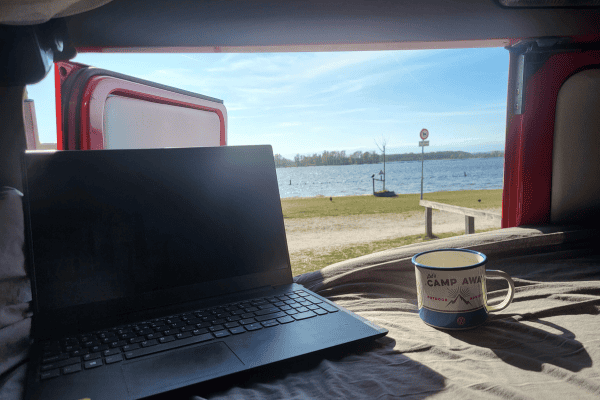
Step 1: Pick a blog name that you love and identify your niche
The first step is definitely the most important one to start with: a name! Because the name will shape the entire idea you have about your blog. It will be your branding and how people find and remember you.
For my first blog, somebody told me the worst advice ever: You don’t need to be in love with your name, you just need a name to start.
Since that blog failed partly because I despised my name a little more each day, I must say, I disagree with this advice.
You need to love your name. You need to be confident about it. Because if you’re not confident about your blog name, you can’t be confident about your blog altogether.
And don’t worry if you don’t have a name idea yet. It’s not something to rush. Please take at least a week to consider it. Even if you already have a name in mind, please take some time to see if it suits you. Maybe even ask people around you what they think. And ask yourself a few questions about your name:
- Does it look good as a domain? (Example: louisesjourney.com looks better than agirlwithavan.com)
- Is it spelled correctly?
- Is your name memorable? Is it catchy?
- Check your name for availability! Is it available in .com?
As simple as choosing a name may sound, there is actually a lot to keep in mind. That is why I highly recommend reading this post about picking a blog name, so you know what to do and, more importantly, what not to do.

What about a niche?
As mentioned before, you will need a specific niche to succeed as a travel blogger. Some bloggers choose something more specific than others, but that is totally up to you!
A broader niche could be:
- Budget travel
- Family trips
- Couples travel
- Vanlife
- Destination-specific (could be a single country, area, or continent)
- Food travel
- Hiking and adventuring
- Road tripping
- Luxury travel
These are just some examples, because the list is truly endless!
Some specific niches could be:
- Vegan food travel
- Train travel through a country or continent
- Ecological travel
- Traveling with toddlers
- Trekking trails
It’ll be easy to figure out which direction you are going with your blog. What do you enjoy writing most about? That is a start. If you don’t know your niche yet, it’ll become clear in time.
I started out writing road trip itineraries for specific European countries. In time, I added city guides and general travel guides about European destinations. I tried writing in more specific niches, such as ecological travel, van life (and van builds), and budget travel, but I quickly realized that it’s hard to write about things you’re not passionate about.
I’m passionate about Europe and its beautiful destinations, keeping me in a broader, more competitive niche, but I seem to have found success in it.
The most important thing is that you enjoy writing articles; in which niche this is, will become clear in time.
Related: The 7 Best Affiliate Programs for Travel Bloggers (With High Commission Rates)

Step 2: Secure your domain name and set up socials
When choosing a name, it’s super important to check if the domain is still available in .com (in my opinion, .com is simply the best. You shouldn’t settle on .info, .net, or anything else). And not only the domain, but also whether the name is available on social media channels, such as Facebook, Instagram, X, Pinterest, etc.
Because if this is not the case, it will become harder for people to find you.
For example: Imagine a reader loves your article and wants to connect with you on Instagram. They search your name, but dozens of variations pop up, and none are obviously you. Finding your profile becomes frustrating, and most people will give up after a few seconds.
You simply lose authenticity and lots of engagement. This is just one example of many possible scenarios. It is best to have the same name on every platform, with minimal variations.
But first things first, you have to check if your name is available as a domain. To do this, visit the Bluehost name checker, enter your name, and check if it’s available as a .com domain. It’s best to have a list of different names that you like and check them all.
As soon as you found a great domain name that is available, check social media for the same name. Available everywhere? Great! Now secure your domain on Bluehost, create accounts on different social media channels, and you’re good!
And no, you don’t need to become active on social media yet. At least you have your name secured; that is the most important thing for now.
Step 4: Install WordPress, choose a theme, and get plugins
Now that you’ve secured your domain name, it’s time to get started with building your website! This step is super exciting, but it may sound overwhelming. Don’t worry, I’ll take you through it step by step.
By securing your website on Bluehost (the most affordable and reliable hosting company to start with), you’ll need to pay approximately $25 for one year of hosting and your domain. After checking out, you’ll be directed to the Bluehost dashboard. Here, you can install WordPress in one click (just ignore the Bluehost website builder and head over to WordPress before doing anything else).
Once you’ve made your way to WordPress, it’s important to pick a theme. To do this, go to the sidebar > Appearance > Themes > Add theme. Now pick a theme that you like. You can preview themes, to see what your website could look like. If you found one that matches your aesthetic, install it and start customizing!
Use this guide to help you pick a WordPress theme.
Use this guide to help you customize your theme.
Plugins
To make your website user-friendly, safe, easy to customize, and so on, you need plugins.
But what are plugins?
A short explanation would be: Plugins are like apps for your blog. They’re small add-ons you can install on WordPress to give your site extra features, like adding a contact form, improving SEO, speeding up your site, or protecting it from spam, without needing any coding skills.
Your website needs certain plugins to function. However, having too many, or too heavy plugins, may cause your website to slow down, resulting in less visitors.
Here’s a list of the plugins your website needs, and why

Step 5: Complete your website
Now, it’s time to make your website yours. To make it personal. By adding all the necessary details. To add pages, photos, stories, and so on.
Pages are very important for your blog, because this is where people can get to know you or get in touch. Some important pages you need are:
- Homepage
- About me page
- Contact page
- Work with me page
- Disclaimer/disclosure page
- Privacy policy
Every page needs a different approach, which is why I linked to more comprehensive guides to how to build each page 🙂
It’s also important to add your own photos to your pages, making your website personalized.
Ps. Don’t launch your website just yet, we’ll do this in a later step

Categories and menus
Another thing you need are menus and categories. If you know what your first blog posts will be, you can make categories for them.
To make categories, go to the WordPress sidebar > posts > categories > add category. Here you can make destination-based categories, niche categories, and so on.
Some examples of my categories are:
- Interrail
- Vanlife
- Oceanside vacation
- City trips
- Volunteering abroad
- Hidden gems
And then every European country that I write about has its own category.
Having categories makes it easier for visitors to navigate your website and find answers to their questions.
After creating your categories, navigate to the sidebar > Appearance> Menus. Here, you can add categories to your website’s menus, so they appear on your homepage. Now, when people want to know about a certain country, for example, they can easily navigate there through your menu.
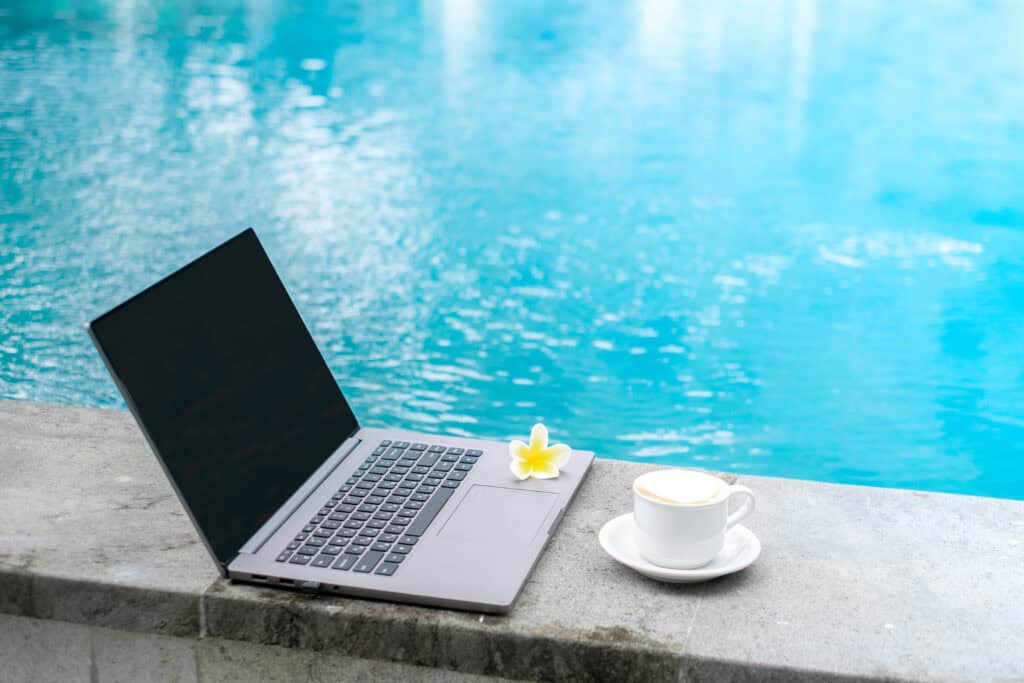
Step 6: Start writing your first blog posts
Now that you have a website that people can visit, it’s time to give them a reason to visit: blog posts.
I highly recommend having 5-10 blog posts published before launching your website. This means that people cannot read your blog posts yet, but once you launch, there are several things for them to read. This makes both your reader and Google happy and gets you started on the right track.
But what exactly makes a good blog post that people actually enjoy reading?
A good blog post:
- Answers a question your reader has
- Is informative but also has some personal stories
- Is over 1500 words long
- Has beautiful photos
- And a clickable title (but no clickbait)
- Has good SEO (Search Engine Optimization)
- Is easy to read (readable font, lots of white space, etc)
Of course, there is an entire formula for what makes a blog post great and popular, and this formula differs for everyone. Throughout the years, I have found out through experience, which blog posts perform well and I used the same techniques for my other blog posts.
During this journey, I read several articles that greatly helped me establish the direction for building my blog posts. I highly recommend reading them below:
- How to Write a Killer Blog Post
- What is E-E-A-T, and why is it important for SEO?
- How Long Should a Blog Post Be: Ultimate Guide and Tips
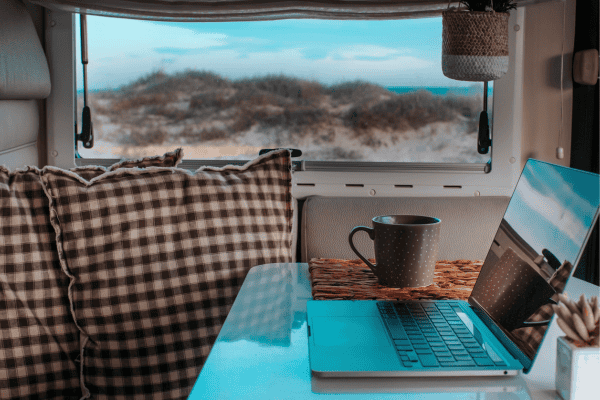
Step 7: Launch your website and share it all over
Now that you have 5-10 blog posts ready to be found, it’s time to launch your website! And just a small disclaimer: this is not an exciting step. Once you launched your website, you will be able to receive visits, but this doesn’t necessarily mean that you will.
And I’m not telling you this to bum you out, but rather to be realistic. It takes time for Google to find out if you’re serious as a blogger. Some call this the ‘sandbox’, which basically means that Google puts you in a sandbox for 6 months, as sort of a test. To see if you’ll stick around.
The best way to approach this is to write and publish blog posts consistently (once every 1 or 2 weeks), and just sit it out. After those 6 months, it’s likely to see some traction, as Google will start ranking you in search results, and people will finally be able to find you.
As long as you focus on implementing a good SEO strategy while writing your blog posts, and just give it time, you will succeed.
In the meantime, you could also focus on getting visitors from different platforms. It’s good to diversify and not lay all your eggs in the Google basket. I highly recommend getting started with Pinterest. This is a visual search engine (read: not social media), where many travel bloggers get a big percentage of their traffic from.
It does take some time to figure out how to create beautiful, clickable pins and to learn where and how to publish them, but it will likely yield results earlier than Google.
Read all about getting started on Pinterest here.
For now it’s simply most important to give it time and keep writing high-quality blog posts. Share them on Pinterest, Facebook, Instagram, whatever suits you best!
Related: The 7 Best Affiliate Programs for Travel Bloggers (With High Commission Rates)
8 success tips for starting your travel blog
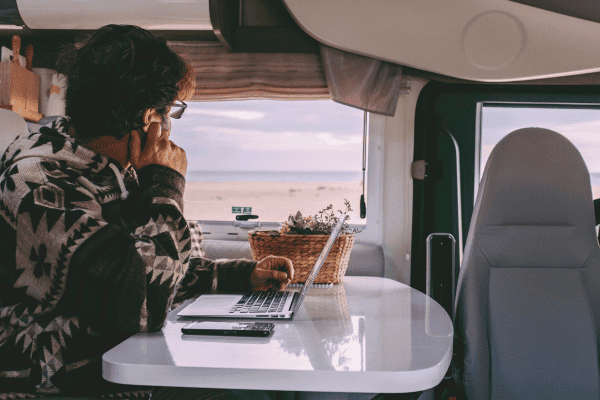
#1 Start now
Realize that you’re not too late to the game. What got me started as a travel blogger, are the following words:
‘’The universe wants something done. It plants the idea in your mind, but if you don’t do anything with it, it’ll start planting the same idea in other minds. As long as it gets done. The name you have in mind today will be gone tomorrow. Start now.’’
It doesn’t matter who or what you believe in, but these words were enough to get me started and I hope they’ll do the same for you.
Start now. Give it time. Be in it for the long game. Never give up.
Get your website off the ground right here, right now!
#2 Know your ‘WHY’
You absolutely need to know your ‘why’. What are you doing it for?
Here’s why you need a ‘why’:
- Your ‘Why’ Fuels Your Motivation: Success requires time, dedication, and hard work. Your ‘why’ is the driving force that keeps you going and helps you stay motivated when the going gets tough.
- Your ‘Why’ Sharpens Your Focus: Your ‘why’ helps you remain on course by connecting you with your core values. By tapping into this vision, you can make better decisions that align with your goals.
- Ignite Your Passion: Connecting with your ‘why’ ignites your passion, allowing you to live authentically and pursue your dreams. This energy will infuse your goals and lead to better results.
- Your ‘Why’ is Uniquely Yours: Without a clear ‘why,’ you risk living life for others. Discovering your ‘why’ empowers you to take ownership of your journey and live on your terms.
To find your ‘why’, ask yourself this:
- What makes you feel alive?
- What gets you out of bed in the morning and keeps you up at night?
- Who do you want to be? Or better yet, where do you want to be?
- What would make the biggest difference in your life?
- What do you need to live your dreams? Time? Money? Freedom?
Know what you’re working for, and you will work towards it. Create a vision board with visuals of your dreams, and you will be reminded of them daily.

#3 Focus on the important things
When I started travel blogging, I focused on everything at once. I was focused on writing SEO content, pinning it, being active on Facebook, email marketing, growing an Instagram page, answering questions in my niche on Quora…
But it was too much. I couldn’t keep up. I read all those blog posts about 30+ ways to get traffic to your blog, and I decided to try them all.
But when starting out, the most important thing is to write content! Lots of it. My rule of thumb is that you need 50+ blog posts to start earning money. Now, you can write 50 posts in a year, or in 3 months. The choice is yours.
All the other things come later. I would still start pinning a little and using Facebook groups for support, but make sure that you’re writing and editing 80% of the time 😊
#4 Keep your expenses low
You are already investing a lot of time before seeing actual money rolling in. Investing money in your blog is certainly a possibility, and it could help you grow, but when blogging the right way, you will still grow, even without big investments.
I highly recommend keeping your expenses low in the first year. Get your domain and hosting on Bluehost, pay no more than $30 for plugins, and consider getting subscriptions to tools like Canva or Keysearch (I used these from the start and don’t regret the expense).
In the second year of your blog, consider switching hosts or upgrading to a paid theme. Hopefully, you’ll have some money rolling in by then to reinvest.

#5 Plug yourself into communities
Facebook groups are the best. People ask all sorts of blog-related questions in these groups, which could really make a difference for your blog. There are even threads to join, allowing you to attract visitors to your blog who share and comment on your posts.
Some of the Facebook groups that helped me most are:
- Blogging for New Bloggers by Lucrezia and Marina
- Blogging Like We Mean It
- DNW – Making Money from Blogging
- Link Building + Guest Posts + Collabs (Travel Bloggers)
- Link Building for Newbie Bloggers
Just plug in, you don’t have to be active, but you never know when you have a question that other bloggers have an answer to.
#6 Create a writing habit
Everyone is different. Some people write better when they have a habit of writing daily (even is it’s just 200 words), while others write huge pieces in just one day.
For me, it’s a mix. I need 2 or 3 days to write 1200-2000 words, which will allow me to create a blog post every 2 weeks.
The most important thing is to keep a habit. Why, you may ask?
Because of writer’s block. Yes, every writer sometimes struggles with it. Chances are that you will struggle with writer’s block as well, at some point in your blogging career. And at some point, you are so far behind that you’re wondering if it’s even worth it and might want to give up.
From my own experience, I have found that having a writing habit helps to prevent writer’s block. To set a goal of writing a certain number of words per day or per week and sticking to it. Sometimes you even find yourself in a flow, so that you end up writing double the words you were aiming for!
So just find what works best for you and stick to it!
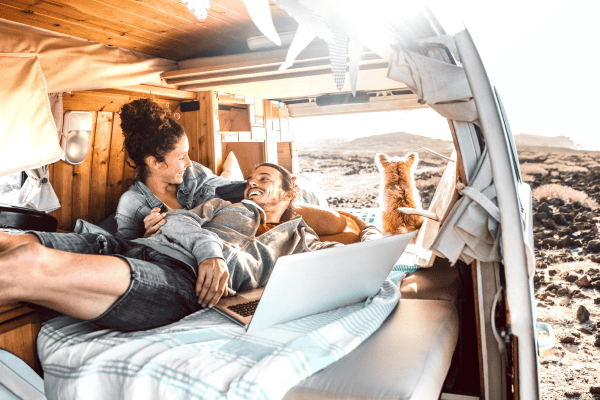
#7 Learn SEO on the go
You don’t need to write perfectly from the start. And you certainly shouldn’t expect yourself to be a wonderful writer who implements SEO the right way, from the beginning.
You will learn on the go. It’s essential to start with some articles (written with your existing SEO knowledge), and then use Google Analytics and Google Search Console to analyze which posts rank best and why. You’ll be able to improve these posts and write your new blog posts with a little more SEO knowledge.
It may feel weird at first, but you can only learn from experience. Of course, some theory is necessary, but when it comes to SEO, sometimes the strangest things work for some bloggers while other stuff works better for others.
#8 Your website and articles don’t have to be perfect
People visit your website for a reason. And it’s not to admire or roast your website. They usually visit your blog post, then leave or hop onto another one of your posts.
Some people who enjoy your writing and want to learn more about you will likely visit your website. For this reason, it’s important that your website works well, is easy to navigate, and has all the important pages.
But beauty?
Your website does not need to be beautiful or perfect. At least not at first. When you start getting some traction, people naturally expect a beautiful website, and you’ll have more time and knowledge to improve its appearance. But please don’t obsess over this from the beginning!
Final thoughts on how to start a travel blog
Now that you know exactly how to start a successful travel blog, it’s time to get started! Get your domain on Bluehost and start blogging for your future, today!
Related posts
How to Start a Successful Travel Blog From Scratch in 2025

